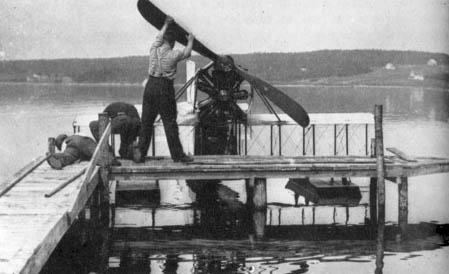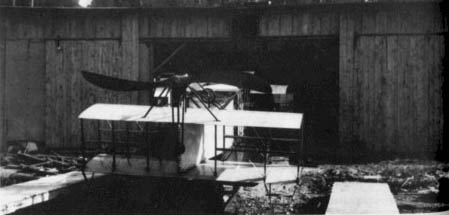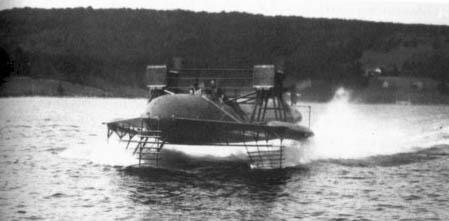Alexander Graham Bell and the Hydrofoils [1906-1921]
Casey Baldwin's [manager of Alexander Graham Bell's estate and laboratory] bent for boating may have encouraged the sea change in Bell's experimental interests during his last years. Casey had already been on the scene for some months when Bell asked himself in October 1906, "Why should we not have heavier than water machines as well as lighter than water? I consider the invention of the hydroplane as the most significant of recent years." A few weeks later he sketched what is now called a hydrofoil boat.
Bell's phrase "heavier than water machine" referred to the fact that such a boat, while in motion, is sustained not by its displacement, like a balloon, but by the lift of its hydrofoils-plates or blades acting in water as airplane wings do in air. As early as 1861 the idea had been successfully tested by towing on an English canal. Bell had probably read the March 1906 Scientific American article by an American hydrofoil pioneer named William E. Meacham, explaining the basic principle. As the speed of a hydrofoil boat increases, the submerged hydrofoils raise the hull until it leaves the water entirely, supported by the vertical stanchions to which the hydrofoils are attached. 'If speed is increased further, the hydrofoils themselves emerge from the water to a point at which their lift is cut back again to the weight of the boat. This automatic reduction of the acting surface area was called "reefing" by Bell and Baldwin, by analogy with sails. Since the ratio between horizontal and vertical forces is fixed by the angle at which the hydrofoils are set, the horizontal force-the resistance to forward motion-likewise tends to be kept constant by hydrofoil "reefing" as speed increases; whereas the resistance of a conventional boat increases as the square of the speed.
Bell and Baldwin did not begin hydrofoil experimentation until the summer of 1908 and even then merely as a possible aid to airplane takeoff from water. But as Baldwin studied the work of the Italian inventor Enrico Forlanini and began testing models, he and Bell turned to hydrofoil watercraft as well. Bell's interest was active and his suggestions astute. Towing trials continued that fall, though plagued with troubles, including the failure of parts under stress. There was a strange, persistent blind spot in Baldwin's thinking, like Bell's disregard of aerial drag; though he as a trained engineer Baldwin was forever overestimating the strength of structural parts or underestimating the stress on them. Nevertheless, the hull of 2 towed hydrofoil-equipped boat lifted clear of the water with Baldwin aboard. And Baldwin designed a ladder-like set of hydrofoil blades slanted so that the lower end of one was on a level with the upper end of another, thus making the reefing action continuous rather than jumpy.
Tests of another hydrofoil-adapted boat ran through the late summer and fall of 1909. The world tour of 1910-1911 interrupted the new line of experiment, but during the journey Bell and Baldwin talked with Forlanini in Italy. "Both Father and Casey had rides in the [Forlanini hydrofoil] boat over Lake Maggiore at express train speed," wrote [Bell's wife] Mabel to her daughter Elsie in the spring of 1911. "They described the sensation as most wonderful and delightful. Casey said it was as smooth as flying through the air. The boat . . . at about 45 miles an hour glides above the water . . . being supported on slender hydro-planes which leave hardly any ripple."

When Bell and Baldwin returned to Beinn Bhreagh late in the summer of 1911, Baldwin designed and built a hydrofoil boat, which he and Bell referred to as a "hydrodrome" and designated the HD-1. Its aerial propeller and short biplane wings for extra lift made it look like a stunted seaplane skittering across the lake that fall in a series of unconsummated takeoffs. After being redesigned and rebuilt during the winter, it was tested again from July to October 1912; and before it cracked up from unknown causes, it had made fifty miles per hour. Rebuilt as the HD-2 and given the unpropitious name of Jonah, it failed to match that speed record before being disabled by a structural failure in December.
Meanwhile, in September 1912, Bell had an alluring vision of hydrofoil sailboats. Baldwin, the experienced sailor, pointed out that the swiftest sailing craft fell far short of the speed required to lift its hull above water by hydrofoils. Bell merely suggested that aerodynamic lift be added through horizontal sails, and he went on to dream of large passenger vessels skating smokeless across the Atlantic on the wings of the wind. So in the summer Of 1913, Casey dutifully worked with Bell on test models.

Early in 1913, at Bell's urging, Baldwin had designed and built the HD-3, Another chunky little quasi-airplane. Its most spectacular moment came when a structural failure led to its turning turtle during a demonstration for the prince of Monaco, whose yacht had put into Baddeck Bay. The HD-3 trials that fall were disappointing; and Casey felt that to put the boat into commission in 1914 would divert too much time and money from further testing of Bell's hydrofoil sailboat ideas.
Though the hydrofoil sailboat dream died in 1914 after a second summer of fruitless trials, the outbreak of the European war that August lengthened the hydrodrome moratorium by two years. Baldwin felt that a private purse .could not finance so expensive a project as the hydrodromes were getting be, and that a government in wartime would not. Bell himself decided as a citizen of a neutral power he should not pursue experiments in Canada that might have naval uses. So in order to save the jobs of the workers, he got Casey to use the laboratory facilities in building small boats for local people and summer residents.
* * *
In 1915 Bell had failed to interest the United States Navy Department in Baldwin's HD-3. His hopes revived after American entry into the war, when the department called for proposals to build submarine-chasers. After offering to build two hydrofoil craft for that purpose, Bell and Baldwin happily pored over old records of towing trials and debated new designs, Then came the government's rejection of the offer. It "fell like a bomb into the camp and shattered all our plans," Bell recorded. But Mabel offered to put up the money anyway, and Bell got the navy to promise the loan of two 400-horsepower Liberty engines. Design work resumed on what was to be the HD-4.

The HD-4 incorporated all that had been learned from the successes and mishaps of its predecessors. It was a sleek gray giant with a cigar-shaped hull sixty feet long, riding on two sets of reefing hydrofoils forward and one aft. On each side was a small hull attached to a solid, streamlined outrigger, for balance while floating at rest. Each outrigger also carried a motor and aerial propeller. Later, a spray shield on each side was tapered from the outrigger hulls to the nose, giving a winged look to the craft and in fact contributing some additional aerodynamic lift. The navy could not or would not furnish the promised Liberty engines, and even the two 2 5o-horsepower Renault engines it sent did not arrive until July 1918. (By then someone had suggested that "HD" stood for "Hope Deferred.") So the first trials did not begin until October 1918.
With the Renault engines, the top speed was only 54 miles per hour. Nevertheless, the HD-4 performed well, rising easily, accelerating rapidly, taking wave without difficulty, steering well, showing good stability. Bell's proud report to the navy early in 1919, along with the postwar availability of Liberty engines, moved the navy at last to send two 350-horsepower Liberties in July 1919. With these powering its two aerial propellers, the HD-4 on September 9, 1919, set a world's marine speed record of 70.86 miles per hour, a record that stood for ten years. '
The sight alone was exhilarating, and the actual ride even more so. "At fifteen knots you feel the machine rising bodily out of the water," wrote one visitor, "and once up and clear of the drag she drives ahead with an acceleration that makes you grip your seat to keep from being left behind The wind on your face is like the pressure of a giant hand .and an occasional dash of fine spray stings like birdshot. . . . She doesn't seem to heel a degree as she makes the turn. It's unbelievable-it defies the law of physics, but it's true." Bell himself would never ride in her. A newsreel photographer (one of several who showed up at Baddeck in that Jubilant season) got Bell to sit in the cockpit of the moored craft, but Bell insisted on having Baldwin's small son beside him to negate any false imputation of daring. Mabel was furious with herself later for not having gone down to make her husband go for a spin while he was in the boat.
A year later Bell managed to get observers from both the British Admiralty and the United States Navy to watch demonstrations. Both delegations made enthusiastic reports. But after long deferred hope, neither navy saw fit to place an order. The United States Navy Department thought such craft too fragile for naval action at sea and preferred a combination of seaplanes and motorboats to any such hybrid of the two. The Naval Disarmament Conference of 1921 dampened British interest. In the fall of 1921 [a year before Bell's death at the age of 75], the HD-4 was dismantled. Its big gray hull lay unregarded for decades on the shore at Beinn Bhreagh [Victoria County, Nova Scotia].
(Reprinted from Bell : Alexander Graham Bell and the Conquest of Solitude by Robert V. Bruce, published by Little, Brown & Company, 1973)
